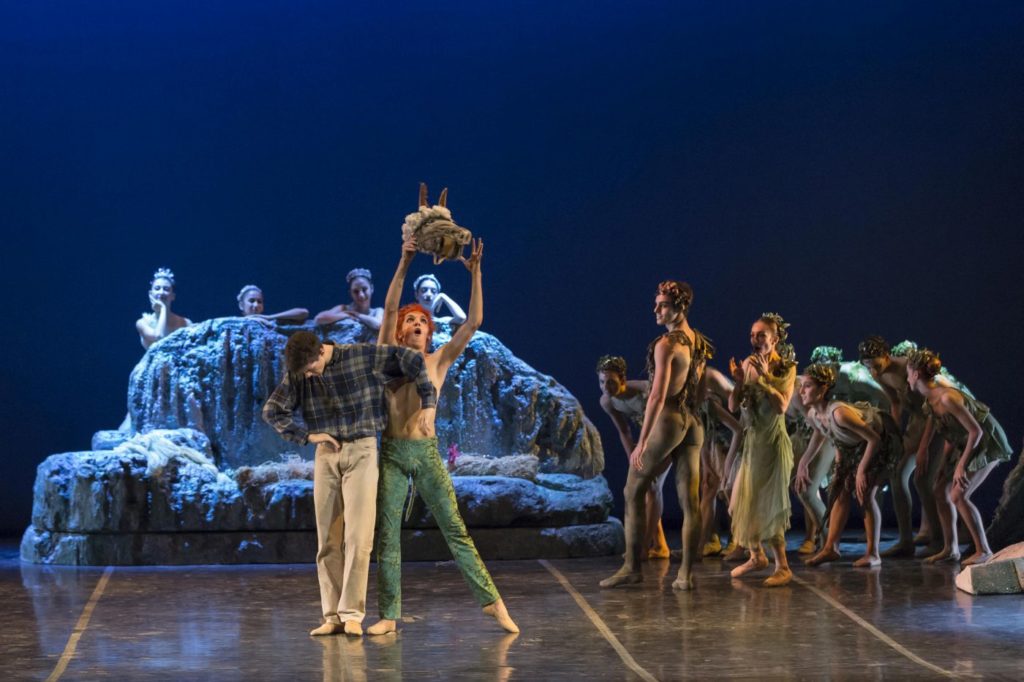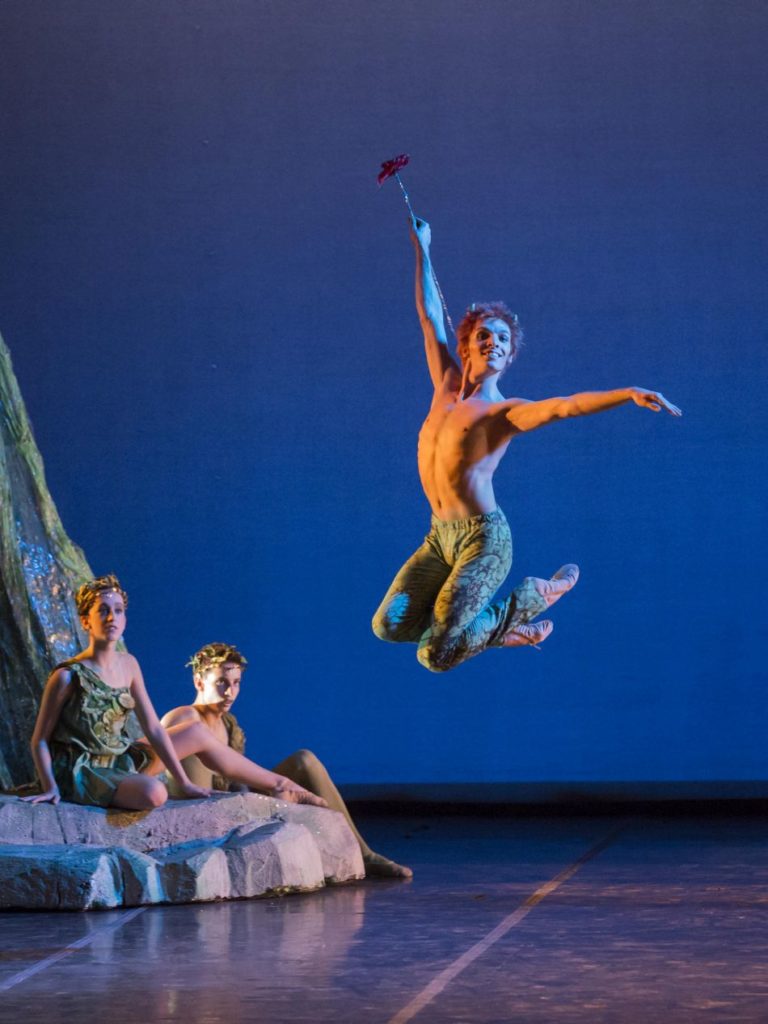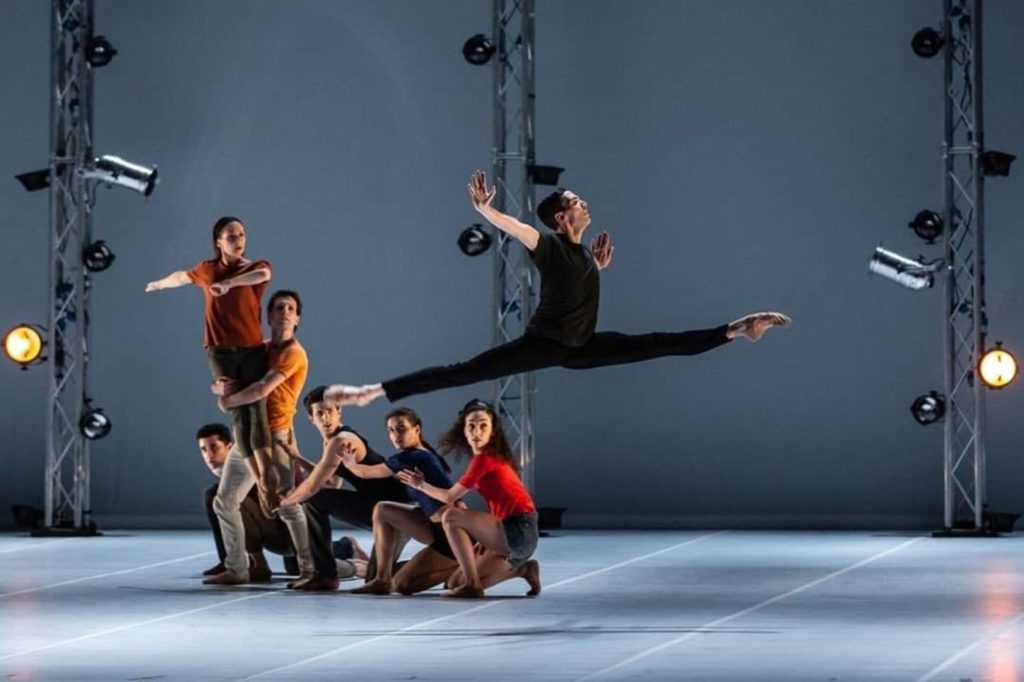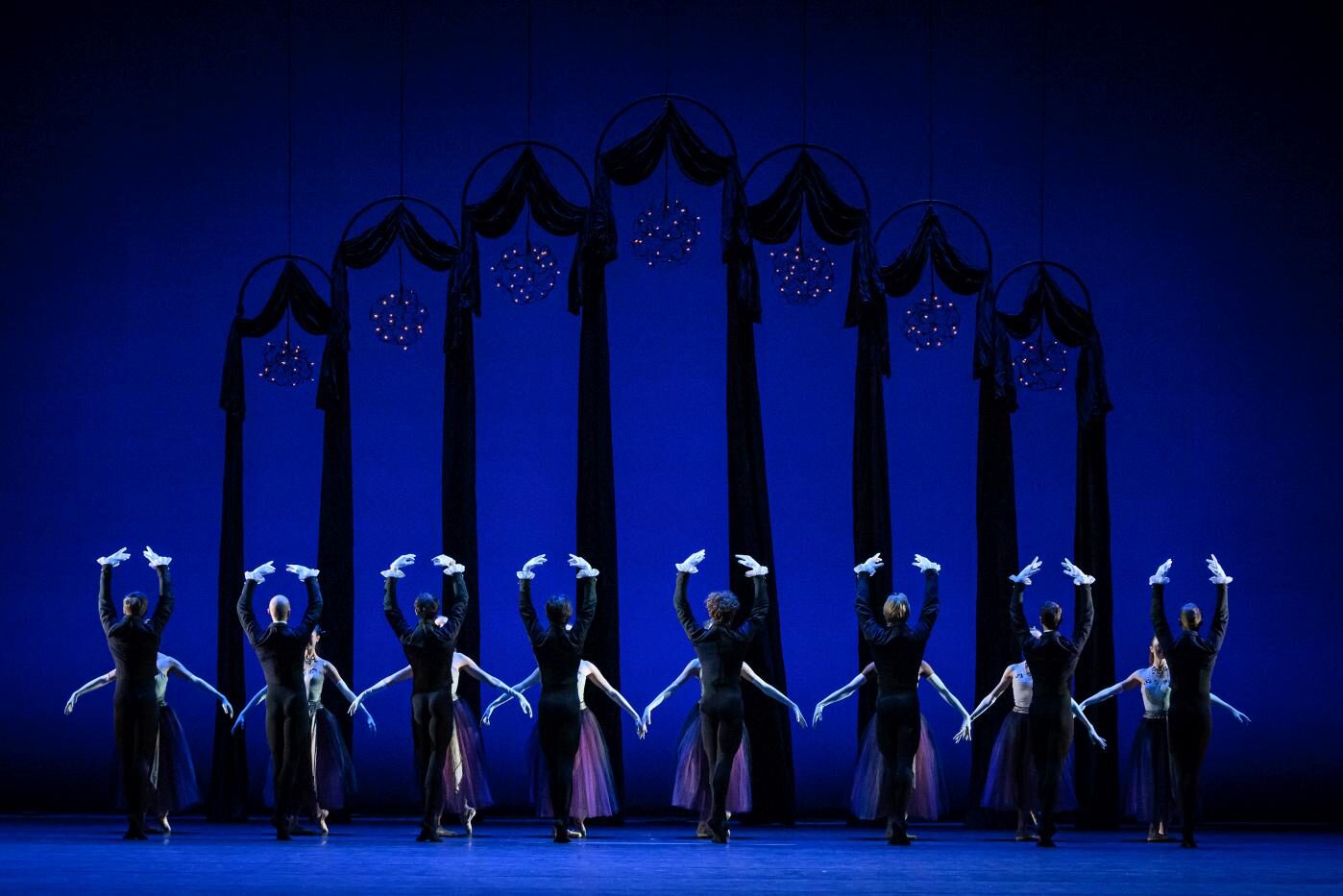“A Midsummer Night’s Dream”
Teatro dell’Opera di Roma Ballet School
Teatro Nazionale
Rome, Italy
May 2021
by Ilona Landgraf
Copyright © 2021 by Ilona Landgraf
 Earlier this May, the Teatro dell’Opera di Roma unearthed an archival recording of a 2014 performance by the opera’s ballet school: Shakespeare’s romantic comedy (or, rather, satire on romantic comedy) “A Midsummer Night’s Dream”, choreographed and directed by Alessandra Delle Monache. Her genre-spanning production is grounded by the explanations of a narrator (Giulia Tomaselli, a student of the Accademia Nazionale D’Arte Drammatica Silvio d’Amico, Rome) who helps us sort out the tangle of romances blossoming in the forests outside Athens. It’s an understandable move, since – unlike in other productions – two of the four couples (Hermia & Lysander, Helena & Demetrius) are dressed so similarly that mixing them up is inevitable.
Earlier this May, the Teatro dell’Opera di Roma unearthed an archival recording of a 2014 performance by the opera’s ballet school: Shakespeare’s romantic comedy (or, rather, satire on romantic comedy) “A Midsummer Night’s Dream”, choreographed and directed by Alessandra Delle Monache. Her genre-spanning production is grounded by the explanations of a narrator (Giulia Tomaselli, a student of the Accademia Nazionale D’Arte Drammatica Silvio d’Amico, Rome) who helps us sort out the tangle of romances blossoming in the forests outside Athens. It’s an understandable move, since – unlike in other productions – two of the four couples (Hermia & Lysander, Helena & Demetrius) are dressed so similarly that mixing them up is inevitable.
What has become of the young dancers seven years later? Three of them agreed to a short interview: Valerio Marisca, Gioacchino Starace, and Alessandro Vinci. (Unfortunately, none of the female dancers who I reached out to wanted to contribute a statement.) Their responses are below:
 Valerio Marisca danced the weaver-cum-actor Nick Bottom, whose head is transformed into that of a donkey by the mischievous sprite Puck. Titania, Queen of the Fairies, falls in helter-skelter love with him – Puck’s doing, but accomplished at the instruction of his master Oberon, King of the Fairies.
Valerio Marisca danced the weaver-cum-actor Nick Bottom, whose head is transformed into that of a donkey by the mischievous sprite Puck. Titania, Queen of the Fairies, falls in helter-skelter love with him – Puck’s doing, but accomplished at the instruction of his master Oberon, King of the Fairies.
What memories do you have of the performance of Midsummer Night’s Dream? Were there any special incidents or surprising moments that have stuck in your mind?
I have some nice memories of the Midsummer Night’s Dream. It was the last show with the school of the Rome Opera House, a few months after the graduation. I really enjoyed  playing the role of Bottom. Alessandra Delle Monache, the choreographer, helped me to find the right comic features of the character, especially when Bottom’s head is transformed into that of a donkey by Puck. Dancing with the donkey mask was not so comfortable; it was very heavy and it was not so easy to find a way to make it look “natural.” I’m very grateful to Laura Comi, the director of the school, and Alessandra Delle Monache for giving me this role, which helped my artistic growth.
playing the role of Bottom. Alessandra Delle Monache, the choreographer, helped me to find the right comic features of the character, especially when Bottom’s head is transformed into that of a donkey by Puck. Dancing with the donkey mask was not so comfortable; it was very heavy and it was not so easy to find a way to make it look “natural.” I’m very grateful to Laura Comi, the director of the school, and Alessandra Delle Monache for giving me this role, which helped my artistic growth.

 What direction has your career taken since then?
What direction has your career taken since then?
After graduating from the school of the Rome Opera House in 2015, I became a member of the ballet company of the Rome Opera house under the direction of Eleonora Abbagnato. In these years I have had many opportunities to dance masterpieces of great choreographers like William Forsythe, Angelin Preljocaj, Benjamin Millepied, Jerome Robbins, Kenneth MacMillan, and more.
 Gioacchino Starace danced Oberon, who caused the mix-up after flying into a rage at his wife Titania’s refusal to relinquish a boy in her charge. He decides to humiliate her by sending Puck to fetch a love-in-idleness (commonly known as a pansy) and spread its magical juice on her eyelids, making her fall in love with the first living creature she perceives upon awakening.
Gioacchino Starace danced Oberon, who caused the mix-up after flying into a rage at his wife Titania’s refusal to relinquish a boy in her charge. He decides to humiliate her by sending Puck to fetch a love-in-idleness (commonly known as a pansy) and spread its magical juice on her eyelids, making her fall in love with the first living creature she perceives upon awakening.
What memories do you have of the performance of Midsummer Night’s Dream?
I remember that I was in the 8th grade, the last year, at the Rome Opera House Ballet School.
I felt a great joy when I learnt that I would dance the main male role of the Midsummer Night’s Dream as first cast. I felt very lucky and, at the same time, I felt the weight of responsibility to represent this prestigious school.

 What direction has your career taken since then?
What direction has your career taken since then?
At the end of my time at the school many good things happened in my life.
Right after graduation I joined the corps de ballet of Teatro alla Scala in Milan where I had the privilege of being able to dance and interpret many roles in some ballets that I would define as masterpieces, such as the “Boléro” by Maurice Béjart, “La Dame aux Camélias” by John Neumeier, and “The Sleeping Beauty“ by Rudolf Nureyev, sharing the stage with etoiles like Roberto Bolle, Polina Semionova, and Svetlana Zakharova.
I also worked with choreographers like Mauro Bigonzetti, Wayne McGregor, Jiří Kylián, Hans Van Manen, Nacho Duato, and Heinz Spoerli.
 Alessandro Vinci danced the impish Puck as a brash fairy spirit (rather than an obedient servant) who flits about the enchanted wood, swinging the love-in-idleness and messing up Oberon’s instructions.
Alessandro Vinci danced the impish Puck as a brash fairy spirit (rather than an obedient servant) who flits about the enchanted wood, swinging the love-in-idleness and messing up Oberon’s instructions.
What memories do you have of the performance of Midsummer Night’s Dream?
When I first played the role of Puck in “A Midsummer Night’s Dream”, I was in my last year at Rome Opera House School; hence, it was a unique and satisfying experience especially because it was the last important role before graduation. That was possible thanks to choreographer Alessandra Delle Monache and my director Laura Comi, who placed a lot of trust in me. Puck was a very comfortable role, since he is a funny and nice character, but the role is also full of technical difficulties that often challenged me.
I remember that a week before the first show I suffered from an ankle injury that caused me a lot of worries and fears of not being able to perform a role into which I had put so much effort. Nevertheless, I managed to fulfill my duties with determination and, above all, happiness.

 What direction has your career taken since then?
What direction has your career taken since then?
After graduation, I became a member of the dance company of the Rome Opera House, directed by Eleonora Abbagnato. Since that moment, I have had the great chance to play a lot of very important roles both as soloist and lead dancer.
The video of the performance will be available for free on the YouTube channel of the Teatro dell’Opera di Roma for approximately one year.

| Links: | Website of the Teatro dell’Opera di Roma | |
| “A Midsummer Night’s Dream” (video) | ||
| Photos: | 1. | Gioacchino Starace (Oberon), Carlotta Onesti (Titania), and ensemble, “A Midsummer Night’s Dream” by Alessandra Delle Monache, Teatro dell’Opera di Roma Ballet School 2014 © Yasuko Kageyama |
| 2. | Valerio Marisca (Bottom), Alessandro Vinci (Puck), Gioacchino Starace (Oberon), Carlotta Onesti (Titania), and ensemble, “A Midsummer Night’s Dream” by Alessandra Delle Monache, Teatro dell’Opera di Roma Ballet School 2014 © Yasuko Kageyama | |
| 3. | Carlotta Onesti (Titania), Valerio Marisca (Bottom), and ensemble, “A Midsummer Night’s Dream” by Alessandra Delle Monache, Teatro dell’Opera di Roma Ballet School 2014 © Yasuko Kageyama | |
| 4. | Valerio Marisca and ensemble, “Hearts and Arrows” by Benjamin Millepied, Teatro dell’Opera di Roma 2019 © Yasuko Kageyama | |
| 5. | Valerio Marisca in a costume of “Nuit Blanche” by Sebastien Beartaud © Valerio Marisca | |
| 6. | Carlotta Onesti (Titania) and Gioacchino Starace (Oberon), “A Midsummer Night’s Dream” by Alessandra Delle Monache, Teatro dell’Opera di Roma Ballet School 2014 © Yasuko Kageyama | |
| 7. | Gioacchino Starace (Gaston Rieux) and ensemble, “Lady of the Camellias” by John Neumeier, Teatro alla Scala 2017 ©️ Teatro alla Scala / Marco Brescia & Rudy Amisano | |
| 8. | Gioacchino Starace, “Boléro” by Maurice Béjart, Teatro alla Scala 2019 ©️ Teatro alla Scala / Marco Brescia & Rudy Amisano | |
| 9. | Alessandro Vinci (Puck) and ensemble, “A Midsummer Night’s Dream” by Alessandra Delle Monache, Teatro dell’Opera di Roma Ballet School 2014 © Yasuko Kageyama | |
| 10. | Alessandro Vinci and ensemble, “Hearts and Arrows” by Benjamin Millepied, Teatro dell’Opera di Roma 2019 © Yasuko Kageyama | |
| 11. | Alessandro Vinci, Vertiginous Thrill of Exactitude” by William Forsythe, Teatro dell’Opera di Roma 2016 © Yasuko Kageyama | |
| 12. | Giulia Tomaselli (Narrator) and ballet ensemble, “A Midsummer Night’s Dream” by Alessandra Delle Monache, Teatro dell’Opera di Roma Ballet School 2014 © Yasuko Kageyama |
|
| Editing: | Jake Stepansky |



